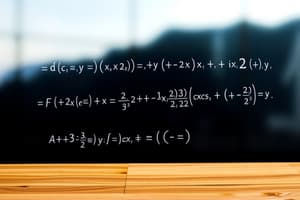Podcast
Questions and Answers
Which of the following conditions must be satisfied for a function to be continuous at a point $a$?
Which of the following conditions must be satisfied for a function to be continuous at a point $a$?
- $ ext{lim}_{x o a} f(x) = f(a)$. (correct)
- $ ext{lim}_{x o a} f(x)$ exists. (correct)
- $f(a)$ is defined. (correct)
- $ orall x$, $f(x)$ exists.
What does the notation $ ext{lim}_{x o a^+} f(x) $ represent?
What does the notation $ ext{lim}_{x o a^+} f(x) $ represent?
- The right-hand limit as $x$ approaches $a$. (correct)
- The left-hand limit as $x$ approaches $a$.
- 1.5
- The function value at $a$.
Which type of discontinuity occurs when the left and right limits exist but are not equal?
Which type of discontinuity occurs when the left and right limits exist but are not equal?
- Jump discontinuity (correct)
- Removable discontinuity
- Continuous discontinuity
- Infinite discontinuity
According to the derivative definition, what does $f'(x)$ represent?
According to the derivative definition, what does $f'(x)$ represent?
When is a function $f(x)$ considered to be increasing?
When is a function $f(x)$ considered to be increasing?
Which of the following describes the Chain Rule in differentiation?
Which of the following describes the Chain Rule in differentiation?
In the context of optimization problems, what are critical points used for?
In the context of optimization problems, what are critical points used for?
Which rule should you apply to differentiate the function $f(x) = u(x)v(x)$?
Which rule should you apply to differentiate the function $f(x) = u(x)v(x)$?
Flashcards are hidden until you start studying
Study Notes
Limits and Continuity
- Limit Definition: A limit evaluates the value a function approaches as the input approaches a specific point.
- Notation: ( \lim_{x \to a} f(x) = L ) means as ( x ) approaches ( a ), ( f(x) ) approaches ( L ).
- Types of Limits:
- One-Sided Limits:
- Left-hand limit: ( \lim_{x \to a^-} f(x) )
- Right-hand limit: ( \lim_{x \to a^+} f(x) )
- Infinite Limits: Indicates the function approaches infinity as ( x ) approaches a value.
- One-Sided Limits:
- Continuity: A function ( f(x) ) is continuous at a point ( a ) if:
- ( f(a) ) is defined.
- ( \lim_{x \to a} f(x) ) exists.
- ( \lim_{x \to a} f(x) = f(a) ).
- Types of Discontinuities:
- Removable: The limit exists, but is not equal to the function's value.
- Jump: The left and right limits exist but are not equal.
- Infinite: The function approaches infinity.
Differentiation
- Derivative Definition: The derivative measures the rate of change of a function ( f(x) ) at a point and is defined as:
- ( f'(x) = \lim_{h \to 0} \frac{f(x+h) - f(x)}{h} )
- Basic Rules of Differentiation:
- Power Rule: ( \frac{d}{dx}(x^n) = nx^{n-1} )
- Product Rule: ( (uv)' = u'v + uv' )
- Quotient Rule: ( \left(\frac{u}{v}\right)' = \frac{u'v - uv'}{v^2} )
- Chain Rule: ( (f(g(x)))' = f'(g(x)) \cdot g'(x) )
- Higher-Order Derivatives: The derivative of a derivative, denoted as ( f''(x) ) for the second derivative, and so on.
Applications of Derivatives
- Finding Tangents: The slope of the tangent line to the curve at a point is given by the derivative at that point.
- Velocity and Acceleration:
- Velocity ( v(t) = f'(t) ) for position function ( f(t) ).
- Acceleration ( a(t) = v'(t) = f''(t) ).
- Critical Points: Points where ( f'(x) = 0 ) or ( f'(x) ) is undefined; used for identifying local maxima and minima.
- Increasing/Decreasing Functions: A function ( f(x) ) is increasing where ( f'(x) > 0 ) and decreasing where ( f'(x) < 0 ).
- Concavity: Examined via the second derivative ( f''(x) ):
- Concave up if ( f''(x) > 0 )
- Concave down if ( f''(x) < 0 )
- Optimization Problems: Utilize derivatives to find maximum and minimum values in various contexts (e.g., profit maximization, cost minimization).
Limits and Continuity
- Limit Definition: A limit describes the value a function approaches as its input gets closer and closer to a specific point, but never actually reaches it.
- Limit Notation: ( \lim_{x \to a} f(x) = L ) means that, as ( x ) gets closer and closer to ( a ), the value of ( f(x) ) gets closer and closer to ( L ).
- One-Sided Limits: These evaluate a function's behavior as it approaches a point from either the left or the right side on the x-axis.
- Left-hand limit: ( \lim_{x \to a^-} f(x) ) looks at the limit as ( x ) approaches ( a ) from values less than ( a ).
- Right-hand limit: ( \lim_{x \to a^+} f(x) ) looks at the limit as ( x ) approaches ( a ) from values greater than ( a ).
- Infinite Limits: Describe situations where the function's output grows unboundedly as the input approaches a specific value.
- Continuity: A function is continuous at a point ( a ) if it meets three conditions:
- ( f(a) ) is defined (the function has a value at ( a )).
- ( \lim_{x \to a} f(x) ) exists (the limit at ( a ) exists).
- ( \lim_{x \to a} f(x) = f(a) ) (the limit equals the function's value at ( a )).
- Types of Discontinuities:
- Removable Discontinuity: The limit at the point exists, but the function's value at that point is different from the limit.
- Jump Discontinuity: The left and right limits exist at the point, but they are not equal to each other.
- Infinite Discontinuity: The function's output grows unboundedly as the input approaches a specific value.
Differentiation
- Derivative Definition: The derivative of a function ( f(x) ), denoted as ( f'(x) ), represents the instantaneous rate of change of the function at a specific point. It's calculated using a limiting process:
- ( f'(x) = \lim_{h \to 0} \frac{f(x+h) - f(x)}{h} ).
- Basic Rules of Differentiation: These rules allow us to find the derivative of functions quickly and efficiently.
- Power Rule: Simplifies the derivative of power functions. If ( f(x) = x^n ) then ( f'(x) = nx^{n-1} ).
- Product Rule: Used to find the derivative of a function that's the product of two other functions. If ( f(x) = u(x)v(x) ) then ( f'(x) = u'(x)v(x) + u(x)v'(x) ).
- Quotient Rule: Used to find the derivative of a function that's the quotient of two other functions. If ( f(x) = \frac{u(x)}{v(x)}) then ( f'(x) = \frac{u'(x)v(x) - u(x)v'(x)}{[v(x)]^2} ).
- Chain Rule: Used to find the derivative of a composite function (a function within a function). If ( f(x) = g(h(x)) ) then ( f'(x) = g'(h(x)) \cdot h'(x) ).
- Higher-Order Derivatives: When you take the derivative of a derivative, you're finding a higher-order derivative.
- The second derivative of a function, typically denoted ( f''(x) ), describes the rate of change of the first derivative.
Applications of Derivatives
- Finding Tangents: The derivative of a function at a given point gives the slope of the tangent line to the function's graph at that point.
- Velocity and Acceleration: Derivatives are key to describing the motion of an object.
- Velocity ( v(t) ) represents the rate of change of the position of an object over time, and is found by taking the derivative of the position function ( f(t) ): ( v(t) = f'(t) ).
- Acceleration ( a(t) ) represents the rate of change of velocity, and is found by taking the derivative of the velocity function, or the second derivative of the position function: ( a(t) = v'(t) = f''(t) ).
- Critical Points: Points where the first derivative either equals zero or is undefined. Critical points are used to identify local maxima and minima of a function.
- Increasing/Decreasing Functions: The sign of the first derivative tells us whether a function is increasing or decreasing:
- A function is increasing where ( f'(x) > 0 ).
- A function is decreasing where ( f'(x) < 0 ).
- Concavity: The second derivative helps analyze concavity.
- A function is concave up if ( f''(x) > 0 ) (the curve is shaped like a cup).
- A function is concave down if ( f''(x) < 0 ) (the curve is shaped like a frown).
- Optimization Problems: Derivatives are used to find maximum and minimum values in practical scenarios, such as finding the maximum profit or minimizing production costs.
Studying That Suits You
Use AI to generate personalized quizzes and flashcards to suit your learning preferences.




